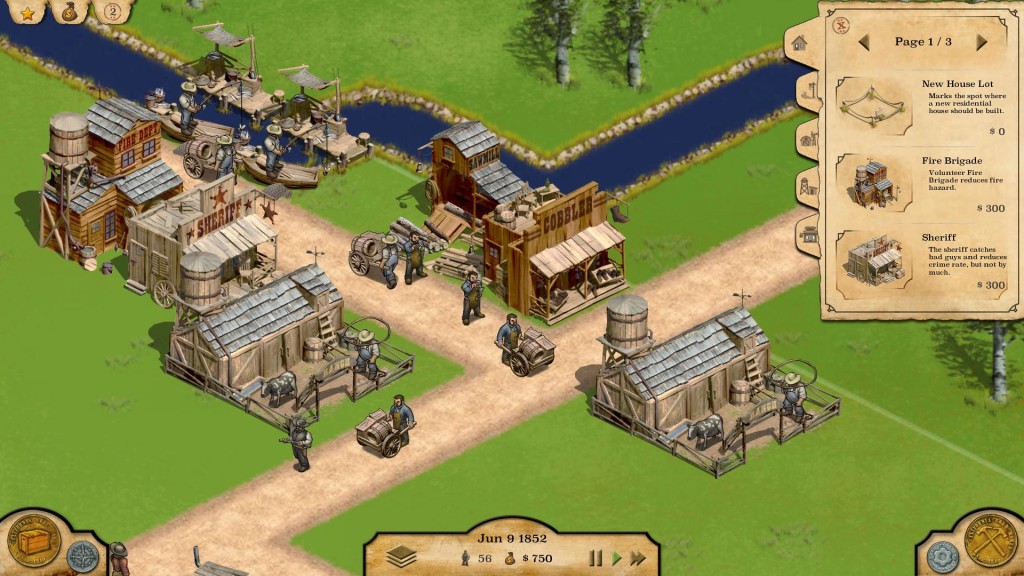Some might find the micromanaging of resources in games like “Caesar IV” and “Banished” to be boring, but to others, it’s heaven. Don’t ask me why, but figuring out how “A” leads to “B” which produces “C” and satisfies “D” is oddly satisfying, at least in my case. “1849”, a Gold Rush-themed city builder, delivers that feeling in spades. While the “Caesar” series challenged me to find synergy during the Roman Empire era, this one took me into a time period that I have yet to fully appreciate. I know jack about the Wild West, except for maybe that time-traveling DeLoreans could reach 88 miles per hour assuming that a train pushed them off a ravine (watch your “Back to the Future”, kids). Before we take a look at what makes this game tick, I’d like to thank Emily Morganti, a PR consultant on behalf of SomaSim, LLC and Matthew Viglione, the co-founder of SomaSim, LLC for providing me with a free press copy.
The main menu keeps things pretty basic in that you’ll be allowed to head to the single player campaign map, continue a previously saved game, or head on over to sandbox mode. The latter will allow the player to select a location on the campaign map, which in turn tells the game to procedurally generate a map based on the area appropriate terrain (similar to Spacebase DF-9). The options menu covers fullscreen & audio toggles, but no screen resolution or graphics quality settings. If this were an action RPG that would be a huge sin, but I often make allowances for business sims & city builders when it comes to graphics quality and the like. While pretty business sims and city builders are certainly a plus, what I really look for is how in-depth gameplay actually is. “1849” has a “Caesar III” look about it, the latter of which was released on or around 1998…just to set your expectations a bit.
What the game lacks in the “pretty graphics” department it makes up for in gameplay. While the campaign maps task you with completing objectives in order to claim victory, you’re not tied down to doing things in just the right way. Maps are generally on the small side and not at all comparable to the size of say, “SimCity 4”, so this game isn’t so much of a city-builder as it is a puzzle game/business sim. While you’ll still be moving citizens into town with the intent on creating a booming economy, the scale is a bit smaller in that you won’t be seeing megalopolises and the like. Rather, you’ll need to make the best use of the space you have to complete your objectives…hence where the “puzzle” part comes into play.
Granted, the maps may not be all that big, but they are still sizable enough to make a town with a population ranging into the hundreds. Like in the “Caesar” series, houses can be upgraded to hold more occupants giving you more space with which to build resource producing structures. There’s also a generous supply of different structures available, giving you different ways to make money. Some resource production buildings have a synergy about them, so you’ll need to pay attention to what you’re producing and what buildings consume what. Having a bunch of wheat fields is useless, for example, without a bakery to turn it all into bread. Campaign maps do limit what structures you’ll have access to, which I didn’t like. It made figuring out what I needed to build and what resources I needed to import much less satisfying.
When it comes to the economy and financial challenge, the game is light to moderate, I feel. I didn’t feel as pressured as I did in “Caesar IV” to get things just right and there was a bit more room for error. With that said, it’s still possible to back yourself into a corner to which there is no escape, if you’re not careful. Spending all of your money on resource producing buildings without buying up the trade routes necessary to sell said resources, is just one example. Yes, I said trade routes…the game takes inspiration from “Caesar IV” in that you have to pay money to unlock routes to distant places, each of which buy and sell different goods. This does force you a bit to focus on resources in demand by other cities, but the game gives you a bit more freedom the further you progress into the campaign.
Overall, “1849” has a lot to offer but does so in such a way to where you won’t need a lifetime supply of Excedrin Migraine to keep up. It’s a somewhat casual experience but still can challenge even the most hardcore city-builder fans. I suspect that part of the game’s design has something to do with the fact that it’s also available on mobile devices, though this isn’t necessarily a bad thing. Don’t let the cartoony graphics deter you, however…there’s plenty of content here to justify its fifteen dollar price tag. It would also serve as a great primer for tougher resource management games like those found in the “Caesar” series, I feel. The campaign can be a little limiting at times with regard to the buildable structures available on any given map, but the sandbox mode helps to alleviate this problem. All in all, a cute (but tough) “little” game.
1849 will officially release on May 8, 2014.
Final Verdict: 8/10
—
You can learn more about and purchase “1849” by visiting the following websites:
http://www.somasim.com/1849/buy.html
http://store.steampowered.com/app/290970
—
Alpha / Beta Gameplay Videos:
https://www.youtube.com/watch?v=I8Pv4GtBkvU
https://www.youtube.com/watch?v=zW18PLIBkhQ
https://www.youtube.com/watch?v=j7Ev7M9EwLc


